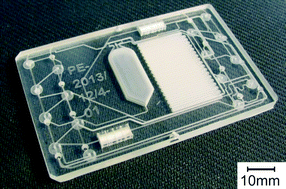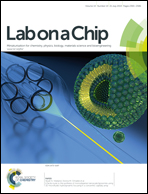A solvent resistant lab-on-chip platform for radiochemistry applications†
Abstract
The application of microfluidics to the synthesis of Positron Emission Tomography (PET) tracers has been explored for more than a decade. Microfluidic benefits such as superior temperature control have been successfully applied to PET tracer synthesis. However, the design of a compact microfluidic platform capable of executing a complete PET tracer synthesis workflow while maintaining prospects for commercialization remains a significant challenge. This study uses an integral system design approach to tackle commercialization challenges such as the material to process compatibility with a path towards cost effective lab-on-chip mass manufacturing from the start. It integrates all functional elements required for a simple PET tracer synthesis into one compact radiochemistry platform. For the lab-on-chip this includes the integration of on-chip valves, on-chip solid phase extraction (SPE), on-chip reactors and a reversible fluid interface while maintaining compatibility with all process chemicals, temperatures and chip mass manufacturing techniques. For the radiochemistry device it includes an automated chip-machine interface enabling one-move connection of all valve actuators and fluid connectors. A vial-based reagent supply as well as methods to transfer reagents efficiently from the vials to the chip has been integrated. After validation of all those functional elements, the microfluidic platform was exemplarily employed for the automated synthesis of a Gastrin-releasing peptide receptor (GRP-R) binding the PEGylated Bombesin BN(7–14)-derivative ([18F]PESIN) based PET tracer.


 Please wait while we load your content...
Please wait while we load your content...